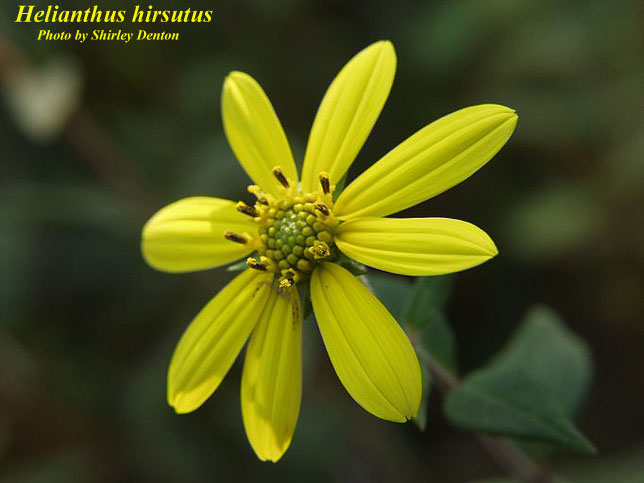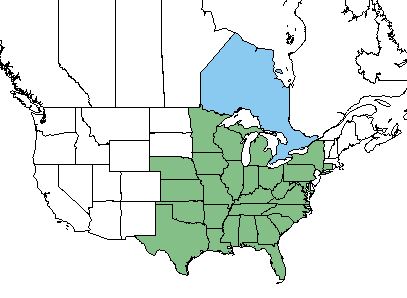Helianthus hirsutus
Common names: hairy sunflower; rough sunflower; coarse sunflower; woodland sunflower
| Helianthus hirsutus | |
|---|---|

| |
| Photo by the Atlas of Florida Plants | |
| Scientific classification | |
| Kingdom: | Plantae |
| Division: | Magnoliophyta - Flowering plants |
| Class: | Magnoliopsida - Dicots |
| Order: | Asterales |
| Family: | Asteraceae |
| Genus: | Helianthus |
| Species: | H. hirsutus |
| Binomial name | |
| Helianthus hirsutus Raf. | |

| |
| Natural range of Helianthus hirsutus from USDA NRCS Plants Database. | |
Contents
Taxonomic Notes
Synonmyms: H. hirsutus var. hirsutus, H. hirsutus var. trachyphyllus Torrey & Gray, H. hirsutus var. stenophyllus Torrey & Gray,
Varieties: none.
Description
H. hirsutus is a perennial forb that is native to the United States[1].
Distribution
While H. hirsutus is present throughout much of the United States, it is most common in the central U.S. states like Missouri, Illinois and Arkansas [1].
Ecology
Habitat
H. hirsutus typically grows in "woodlands and other sunny or semi-sunny habitats" [2]. It has been frequently found in ecotones at the edges of hardwood and mixed woodland forests. This species can grow in dry and moist loamy and rocky soil. It also grows in disturbed areas and areas that are burned regularly [3].
Phenology
This species flowers from July through October [2].
Fire ecology
This species can be found in areas that are burned regularly [3]. It responds positively to fire, increasing in numbers after frequent fires. [4]
Use by animals
H. hirsutus is a much palatable species for white-tailed deer. [5]
Conservation and Management
Cultivation and restoration
Photo Gallery
References and notes
- ↑ 1.0 1.1 USDA Plants Database URL: https://plants.usda.gov/core/profile?symbol=HEHI2
- ↑ 2.0 2.1 Weakley, A. S. (2015). Flora of the Southern and Mid-Atlantic States. Chapel Hill, NC, University of North Carolina Herbarium.
- ↑ 3.0 3.1 Florida State University Robert K. Godfrey Herbarium database. URL: http://herbarium.bio.fsu.edu. Last accessed: May 2018. Collectors: Loran C. Anderson, M. Morgan, Delzie Demaree, A. F. Clewell, Paul L. Redfearn Jr., Kathleen Craddock Burks, Gary R. Knight, Harry E. Ahles, J. A. Duke, R. D. Houk, Scott McCoy, Wilbur H. Duncan. W. C. Holmes, John B. Nelson, D. A. Raynerm S.W. Leonard, J. Moore, Norlan C. Henderson, George T. Jones, H.R. Bennett, D. S. Correll, H. B. Correll, Charles S. Willis, Carol L. Howel, Kevin Oakes, Richard Gaskall, J. M. Kane, Billie Bailey, Bob Farley, Brian R. Keener, R. Kral, and George Apthorp. States and Counties: Alabama: Cullman, Crenshaw, and Sumter. Arkansas: Garland, Conway, Logan and Lonoke. Florida: Clark, Jackson Leon, Gadsden, and Wakulla. Georgia: Butts, Thomas and Madison. Indiana: Harrison, Lake, Sullivan and Porter. Louisiana: Natchitoches. Missouri: Johnson, CassStone, Laclede, Greene, Douglas, and Clinton. North Carolina: Haywood and Nash. Ohio: Erie. Oklahoma: Latimer. South Carolina: Abbeville and York. Texas: Bowie and Newton.
- ↑ Sparks, J. C., et al. (1998). "Effects of late growing-season and late dormant-season prescribed fire on herbaceous vegetation in restored pine-grassland communities." Journal of Vegetation Science 9: 133-142.
- ↑ Burton, J. A. (2009). Fire frequency effects on vegetation of an upland old growth forest in eastern Oklahoma. Environmental Science. Stillwater, Oklahoma, Oklahoma State University. Bachelor: 78.